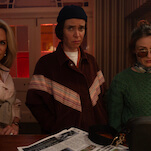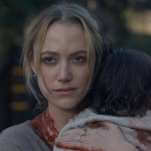Here’s something I never thought I’d say: Thank god for Kickstarter stretch goals. At some point during the crowdfunding campaign for Bloodstained: Ritual Of The Night, Koji Igarashi’s much-hyped return to the form he so thoroughly perfected with Castlevania: Symphony Of The Night and its Game Boy Advance successors, the team offered to make a “mini-game” prequel if contributions crossed a certain threshold. It’s a good thing that goal was shattered, because the promised precursor, which recently materialized as Bloodstained: Curse Of The Moon, is a brilliant throwback to Castlevania of a different sort: the moody, trollishly difficult 8-bit adventures of the series’ NES era.
Where Curse Of The Moon really breaks into its own modern take on Castlevania III’s epochal template is its spin on the party system. You eventually unlock a group of four warriors, each with unique sub-weapons and traversal abilities. You can swap between them at the touch of a button, and the game takes full advantage of the immediacy, seemingly designing certain rooms with certain characters and abilities in mind. For instance, walking your sword dude and his short, horizontal slice across a bridge covered in hopping frogs might be a PTSD-triggering nightmare, but swap him for your alchemist and his shielding ring of fire, and you can stroll across without a care in the world. Passive abilities like that shield or the swordsman’s attack buff even carry over between characters, letting you pop them, then switch to someone else for a useful combination. Between that kind of flexibility and the slightly brisker pace at which the whole thing moves, Curse cleverly turns character swapping into a crucial problem-solving skill, each character having their time and place down to individual monsters, obstacles, or even boss attacks.
It does lead to some issues with the way the game handles death, though. Each character has a separate health bar, and if one perishes, they stay gone while the rest can venture forward; you only lose a life once every party member falls. It’s a fine idea on its own—forcing you to rethink your approach to a room you might have dominated with the proper fighter—but it can lead to some unnecessary time wasting when, say, you’re facing a boss and left only with your alchemist character’s stubby wand and defensive magic. At that point, you might as well take the L and start from scratch. Worse, most of the levels’ alternate pathways are dependent on you having a specific character around, usually the vampire for his bat transformation, and if they died earlier on, you’re shit out of luck and will have to pass up whatever treasures may lie down that route, including valuable permanent upgrades. The developers design around this a bit by including an option to rewind your game to the start of any previous level, but the backtracking that saddles you with feels more like a punishment for an unforeseeable mistake than a merciful convenience.
The game is only a few hours long, though, and the levels are winding and secret-filled enough to support that kind of repeated exploration. And while the developers may not have figured out how to mercifully handle losing a party member, they did put a lot of effort into creating varied difficulty options that can appeal to different kinds of players. If you’re looking for a more traditional Castlevania experience—with limited lives and that goddamned knock-back effect that so often sends you flying into pits when you get hit by a pathetic flying head—Curse Of The Moon has you covered. If you’d prefer the modern comforts of unlimited lives and no knock-back, there’s the “casual” mode. (Sadly, there’s no option to introduce a bit of mid-air mobility to your jumps, a tradition that leads to even more frustrating deaths than the whole knock-back thing.) Once you start finishing the game, you’ll also unlock additional difficulties and permutations that force you to change the strategies and reflexes you’ve already built. They’re exactly the kinds of transformative, life-extending twists a game of this size and shape need to add extra life to subsequent playthroughs.
The symbolic connections between Curse Of The Moon and Dracula’s Curse are plenty novel—with Castlevania III being the distant narrative beginning of a loose in-series trilogy that culminated in Symphony Of The Night, just as Curse Of The Moon leads into Ritual Of The Night—but with any game as explicitly reverent as this, there’s always the question of whether it manages to iterate more than it imitates. Here, the developers at Inti Creates walk that line expertly, borrowing concepts, characters, and even set pieces directly from Castlevania III, but mindfully tweaking them into a form that feels both familiar and modern. If Ritual Of The Night turns out to be half this clever at refining its equally legendary inspiration, then it may end up being worth the wait.







































